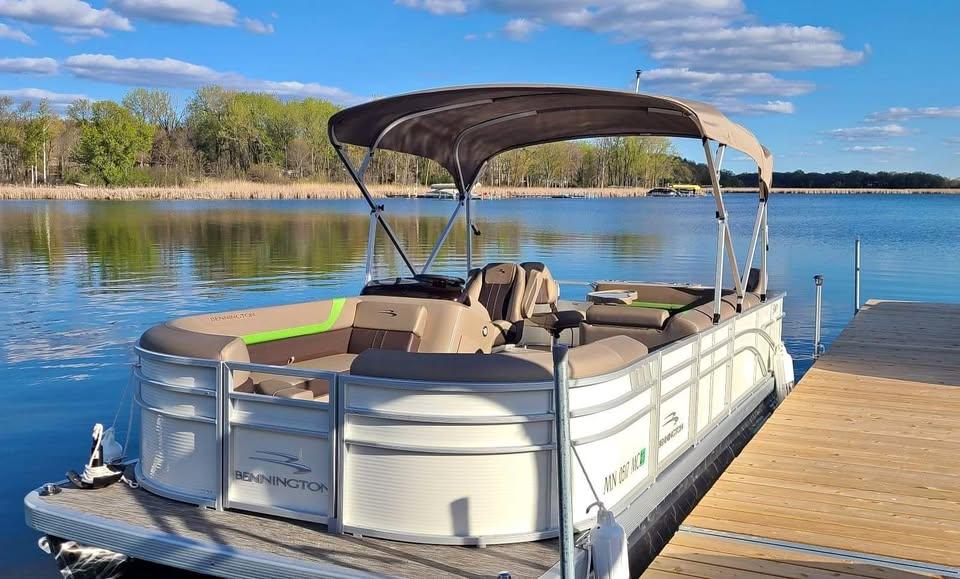New vs. Used Pontoon Boat: A Buyer’s Guide for First-Time and Returning Buyers



Introduction
Buying a pontoon boat is an exciting decision, but one big question looms for many U.S. buyers:
Should you buy a brand-new pontoon or save money with a used pontoon and refurbish it?
Both options have their merits.
New pontoons offer turn-key convenience and the latest features, while used pontoons can be budget-friendly and highly customizable through refurbishment.
In this guide, we’ll compare:
- Average costs of new vs. used pontoon boats (including refurbishment costs)
- Ongoing maintenance requirements and cost considerations
- Customization potential, focusing on used pontoons offering more flexibility
- Pros and cons of each option
- Buyer recommendations based on budget vs. convenience needs
By the end, you’ll have a clear recommendation based on your priorities. Let’s dive in!

A modern pontoon boat with comfortable seating and a bimini top.
Cost Comparison: New vs. Used Pontoon Boats
New Pontoon Boat Costs
A basic 20-foot new pontoon with a modest engine (around 60 HP) and standard features costs about $18,000–$22,000.
Larger or luxury models (e.g., a 25-foot pontoon with high horsepower and premium amenities) can range from $40,000 to $70,000+, with some high-end models exceeding $100,000.
Used Pontoon Boat Costs
A comparable 20-foot used pontoon (a few years old) might sell for $12,000–$18,000, depending on condition and features.
Since pontoons depreciate about 10% per year, a four-year-old pontoon might cost roughly 20% less than new, while a 10-year-old pontoon could be 35%+ cheaper.
Refurbishment Costs
If you buy a pre-owned pontoon that needs work, here are typical upgrade costs:
- Minor refresh: $500–$2,000 (cleaning, new carpet, minor repairs)
- Moderate refurb: $3,000–$5,000 (new flooring, upholstery, electrical work)
- Full refurbishment: $5,000–$10,000+ (deck replacement, all-new furniture, engine upgrades)
For example, one owner spent $10,000 restoring a $5,000 pontoon, replacing flooring, seating, and adding premium features.
Total Cost Considerations
If you buy a used pontoon and refurbish it, you may still spend less than a new one. However, if major repairs arise (like an engine replacement), costs can add up.
Always calculate purchase + refurbishment costs and compare to a new boat’s price before deciding.
Maintenance Costs and Considerations
New Pontoon Maintenance
New pontoons require minimal maintenance early on, with costs averaging 2% of the boat’s value per year.
For a $30,000 pontoon, expect to spend $600 annually on routine upkeep like:
- Engine oil changes
- Fuel system checks
- Upholstery and flooring care
- Cleaning and winterization
Used Pontoon Maintenance
Used pontoons can require more frequent repairs, with maintenance averaging 10% of the boat’s value annually.
For a $15,000 used pontoon, that means around $1,500 per year, accounting for:
- Unexpected repairs (steering cables, fuel system fixes, etc.)
- More frequent upholstery replacements
- Catching up on previous owner’s deferred maintenance
If you buy used, budget extra for unexpected maintenance costs.
Customization and Upgrades: New vs. Used
New Pontoon Customization
When ordering a new pontoon, manufacturers offer factory-installed upgrades like:
- Premium sound systems ($1,500+)
- Luxury seating layouts
- Ski tow bars, LED lighting, and performance packages
However, you’re limited to the manufacturer’s options, and post-purchase modifications can be difficult or costly.
Used Pontoon Customization
With a used pontoon, customization is nearly limitless, allowing you to:
- Install aftermarket sound systems, lighting, or furniture
- Choose marine flooring (vinyl, woven mats, etc.)
- Modify seating layouts and accessories
Many boaters enjoy upgrading their used pontoons gradually, making it the perfect choice for DIY enthusiasts.

A refurbished pontoon interior with upgraded flooring and seating.
Pros and Cons of Each Option
| Factor | New Pontoon | Used Pontoon (Refurbished) | | ----------------- | ------------------------------- | -------------------------------------- | | Cost | Higher upfront ($18k–$70k) | Lower upfront ($8k–$20k) + refurb cost | | Maintenance | Low early on, warranty coverage | Higher, unexpected repairs possible | | Customization | Limited to factory options | Fully customizable | | Depreciation | Loses ~10% per year | Slower depreciation | | Reliability | Warranties, fewer breakdowns | May need repairs, no warranty | | Availability | May require factory order | Available immediately |
Conclusion
Choosing between a new or used pontoon depends on your priorities:
- If budget is key → Go used and refurbish it
- If convenience is key → Buy new for warranty and peace of mind
- If you want the best deal → Find a lightly used pontoon
Either way, pontoons offer years of enjoyment on the water—the key is finding the right one for your needs!
Keywords: Pontoon boat buying guide, new vs used pontoon, pontoon refurbishment, pontoon maintenance, used pontoon costs, new pontoon costs, pontoon boat upgrades, pontoon customization.
Have questions about buying a pontoon? Drop a comment below!